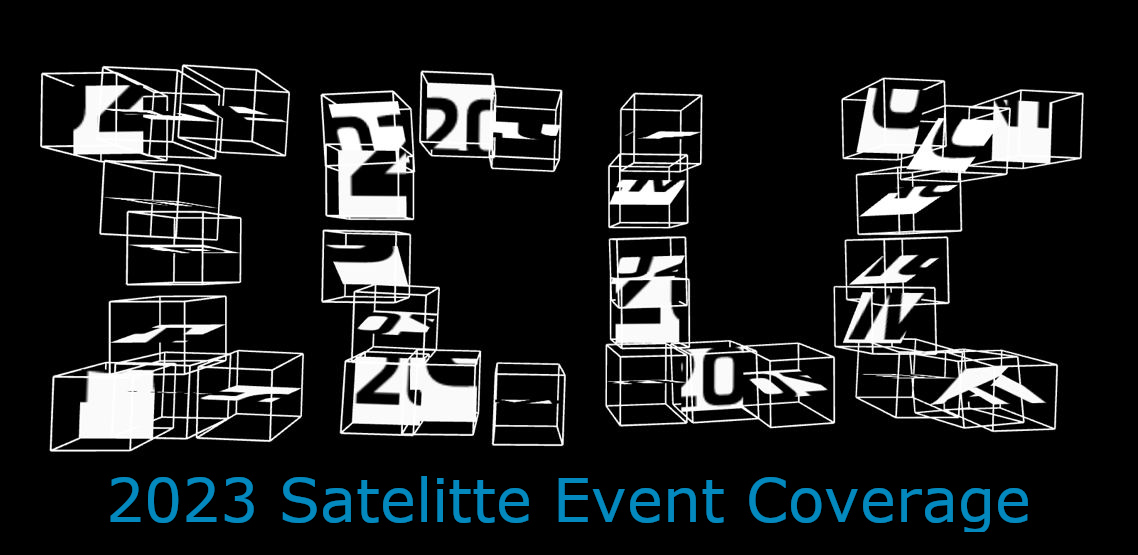Reviewer: J Simon van der Walt
Concert: ICLC Satellite Event at the Institute of Sonology – MultiChannel Compositions
Date: 2023-04-18
The penultimate warm-up concert before ICLC begins for real in Utrecht took place at the Institute of Sonology in The Hague. Since I last visited, the Royal Conservatoire has opened a shiny new venue. The New Music Lab in which the concert took place was particularly impressive, a clean and spacious room with a high-spec 12 channel audio-system coupled with a gigantic projection screen. The audience of around 60 people were seated in the middle of the space, which was more or less blacked-out for most of the concert: great for listening to the music and watching the visuals, but a bit of a problem for reading the printed programme!
There were seven performances. The first was given by Kosmas Giannoutakis (SuperCollider) and Aaron Juarez (Hydra), entitled Serendipitous Liquidators, and involved re-using snippets of openly published code by other authors. The piece was long (25 minutes), with intense sound and visuals throughout.
With Luca Faraldi’s Improvisation, no code was projected: this was something I noticed particularly with performers associated with the Institute of Sonology itself. Perhaps ‘show us your screens’ is not part of their aesthetic? This piece was intriguingly short, with sparing and careful use of a small number of gestures. The dynamic range was very wide indeed: one loud gesture in particular was unfortunate, causing my hearing aids to distort and many in the audience to clap their hands over their ears.
Caspar Shipper slightly threw us all by quietly announcing that they were not going to perform the piece advertised in the programme, but do ‘something else’ instead. What we got was simple and controlled, beginning with nothing more than some sine waves coded what looked like Lisp, with the subtle addition of some harmonics as the piece progressed. We were watching the code here: it was a bit of a surprise when we then saw some simultaneous code in SuperCollider, also based on sines, and then something I could not follow in the terminal that seemed to be related to ChucK. The performance was well-paced and just the right length, with a refreshing simplicity of aural materials.
Farzeneh Nouri presented Énactuer x Énactuer III. The programme note revealed that this would be a duet – or duel? – between ‘two AI-driven agents’, but as once again we did not see any code, it was hard to know what was doing on. This piece was more overtly spatial than some of what we had heard before, with a wide variety of impressive-sounding electroacoustic gestures covering a wide frequency range.
Seriana Fässler’s Live Performance was very interesting. It began with a single unexpected loud beep, which was then followed by what felt like several minutes of mostly silence, punctured by audience members whispering amongst themselves and even, at one point, beginning to applaud in case that was the end of the piece! From this odd beginning the piece developed in a very intersting way, which one surmised might have been elaborations of the opening sound: no code projected, so no way to tell. By the end there was a very rich and rewarding sound world, somewhat like bowed strings, with hints of pulse and even harmony in places.
Jia Liu’s Vinculum was very impressive, certainly in sound, but also in its careful visual presentation. Everything was done in stark white on black. There was the SuperCollider IDE with the code and the post window, while on the right were two animations, a circle of dots sometimes joined by lines, and a vertical stripe of waveforms. With over 200 lines of SC code this was a rich and complex environment, which Jia manipulated over the course of an extended improvisation to produce a satisfyingly wide range of sounds and gestures.
With ‘Limen’ by Francesco Corvi and Flor de Fuego, we were able to see the code and visuals that Flor was using in Hydra, but not Francesco’s code. Thinking back on the performance, I realise that as a consequence I spent most of my time concentrating on the visuals, and rather took the music for granted. As with the previous performance, Flor’s pallette was deliberately limited to black and white, which still allowed for a very wide range of those morphing feedback textures that Hydra is so good for. Franesco’s music was well matched with the visuals, with rich and complex synthesised gestures punctured by near silence.
All in all, it was great event and good way to get us ready for more! Thanks for the Sonology Institute team for organizing.
J Simon van der Walt
